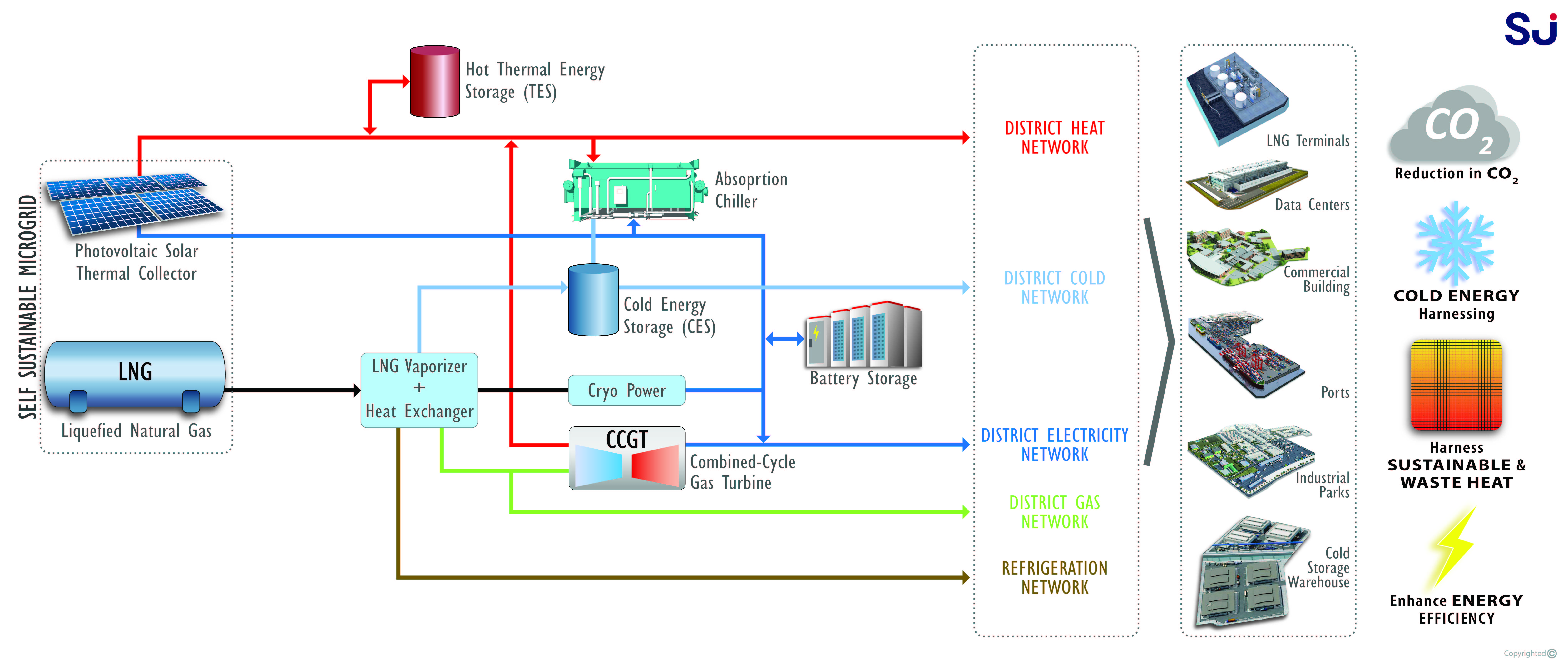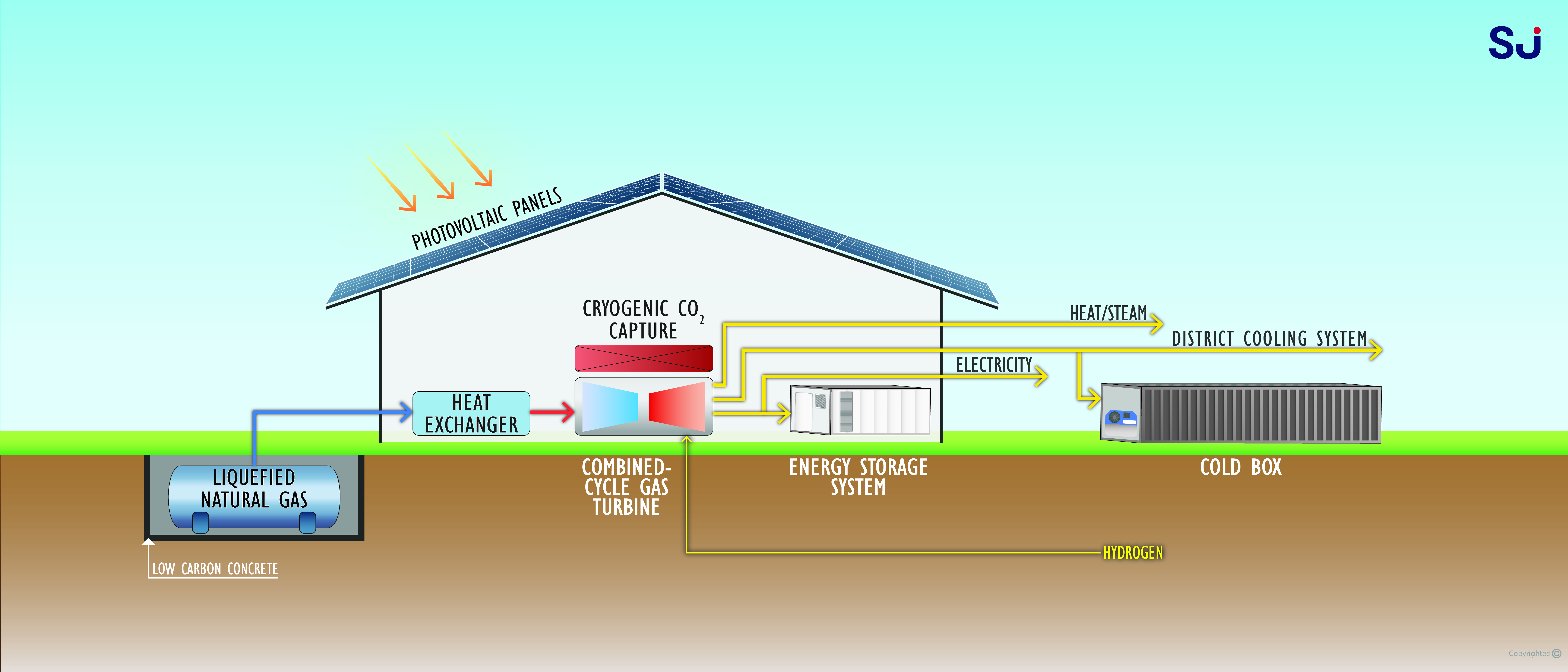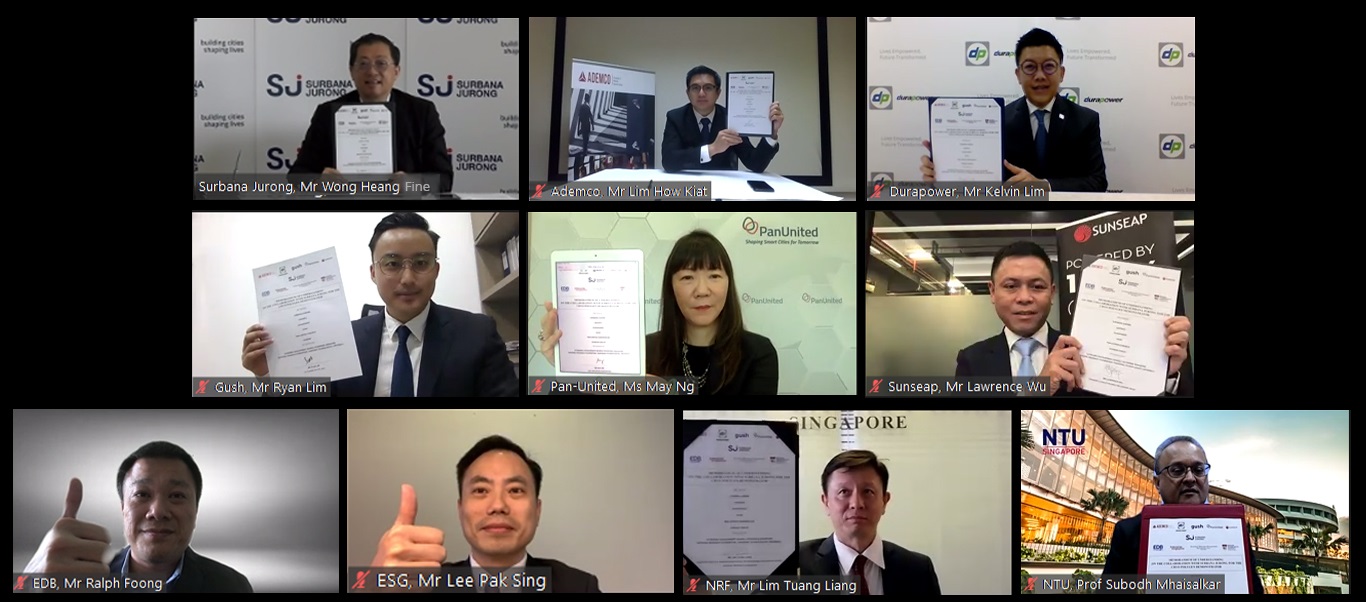Surbana Jurong and NTU to develop hybrid system to deliver cleaner and more sustainable energy from LNG
Singapore, 21 July 2020 – To deliver cleaner, more sustainable energy, Surbana Jurong and Nanyang Technological University, Singapore (NTU Singapore) are developing an integrated urban power generation system that can harvest, store and use cold energy from the regasification of Liquefied Natural Gas (LNG), with the option of using liquefied hydrogen as an additional source of energy.
Called “Cryo-Polygen”, this solution combines the concurrent generation of electricity, gas, cold energy, steam and hot water into a single plant operation.
To test and validate Cryo-Polygen, a pilot testbed will be built on the NTU campus by 2022, near the Surbana Jurong Campus in Jurong Innovation District.
The innovative hybrid system is expected to become commercially available and play a part in reducing carbon footprint and helping Singapore reach its goal of 36 per cent carbon emissions’ reduction by 2030. The cold energy generated from the system can be used to power cold storage warehouses and to cool data centres, industrial parks and buildings.
The Cryo-Polygen project is one of several innovations being developed under the SJ-NTU Corporate Laboratory. Jointly launched in 2018 by Surbana Jurong and NTU, and supported by the National Research Foundation (NRF) and Singapore Economic Development Board (EDB), it aims to develop next-generation sustainable solutions to tackle industrial and complex urban challenges.
The joint SJ-NTU team is also studying the feasibility of locating LNG storage and its related facilities underground in the future. Conventionally, LNG is stored in large-scale cryogenic storage tanks and in Floating Storage Regasification Units located near ports, industrial parks and power generation plants.
Such underground solutions free up the land above for higher value uses. The power supply can also be decentralised and situated closer to infrastructure that requires cold energy, including data centres, cold storage warehouses and hospitals.
Mr Wong Heang Fine, Group Chief Executive Officer, Surbana Jurong, said, “The Cryo-Polygen innovation will be a game changer for sustainable innovations to reduce carbon emissions. Several companies have expressed their interest in applying the Cryo-Polygen innovation to enhance their business delivery. Surbana Jurong is leveraging our vast experience in urban and infrastructure consultancy in the oil and gas sector to drive this innovation in Singapore as well as internationally through our member companies. As Cryo-Polygen produces efficient, cleaner and more sustainable energy, it has the potential to help meet demand for clean energy, reduce our carbon emissions and combat climate change.”
Professor Lam Khin Yong, Senior Vice President (Research), NTU Singapore, said the joint Cryo-Polygen testbed shows the benefit of academia-industry partnerships, where NTU’s cutting-edge research combined with the deep industry expertise of SJ, can produce novel solutions to help address pressing challenges faced by Singapore and other urban cities.
“Over the last decade, NTU has built extensive interdisciplinary research capabilities in the areas of sustainable energy, particularly in the areas of next-generation solar power, thermal energy harvesting, rechargeable batteries, green data centres, AI and power systems integration, which will contribute greatly to our collaboration with Surbana Jurong. The NTU Smart Campus is already a living testbed of advanced technologies ranging from autonomous electric vehicles and maritime energy to waste-to-energy technologies and renewable energy integration developed in close partnership with industry,” said Prof Lam.
Professor Low Teck Seng, NRF Chief Executive Officer, said, “The partnership between Surbana Jurong and NTU under the SJ-NTU Corporate Laboratory has seen good progress in translating research outcomes to commercialisation. The Cryo-Polygen research, which is an excellent initiative towards reducing our carbon footprint, is testament to that. The joint effort also provides a platform for local companies to showcase their sustainable innovations, and it strengthens our ability to export next-generation smart and urban solutions to other cities facing similar urbanisation challenges. The SJ-NTU Corporate Laboratory underscores Singapore’s capabilities as a regional innovation hub that redefines cities and transforms them into sustainable and liveable spaces for communities and businesses to flourish.”
Mr Damian Chan, Executive Vice President, EDB, said, “The Cryo-Polygen innovation project is an example of the progress being made by the SJ-NTU Corporate Laboratory. The project has the potential to help Singapore achieve several goals, including reducing carbon emissions and developing sustainability solutions that can be commercialised internationally.”
Climate Change Demonstrator Plant
The new testbed to be built on the NTU Smart Campus will have a “Climate Change Demonstrator”, which shows how cold energy can be harvested, stored and optimally used to refrigerate a container at sub-zero temperatures. The demonstrator plant will be the first of its kind in Southeast Asia.
Spearheading the project will be Surbana Jurong Senior Director, Oil & Gas, Mr Tan Wooi Leong, and NTU Associate Professor Alessandro Romagnoli. NTU will contribute its expertise on the recovery, storage and utilisation of cryogenic energy to complement Surbana Jurong’s industry knowledge and experience in LNG and power systems integration.
The demonstrator provides a platform to showcase best-in-class sustainable innovations and their joint contributions towards a reduction of carbon emissions within the Cryo-Polygen system. Enterprise Singapore (ESG), the government agency championing enterprise development, partnered Surbana Jurong to identify local companies with solutions most suited for this showcase. Through ESG, Surbana Jurong has secured partnerships with five Singapore companies:
• Ademco, a security services company, to provide security solutions, in collaboration with AETOS, a member of Surbana Jurong Group;
• Durapower, a Singapore company with a global presence, specialising in research, design, manufacture, and system integration of advanced lithium battery solutions and charging systems for electric mobility and stationary energy storage systems, to provide the battery energy storage system;
• Pan-United Corporation, a technology company focused on concrete product innovation, to provide low embodied carbon concrete with almost half the carbon footprint as compared to normal concrete;
• Sunseap Group, the leading clean energy solutions provider in Singapore, specialising in solar, demand-side management and energy efficiency solutions, to provide the solar photovoltaic system; and
• gush, a Singapore startup specialising in sustainable advanced materials that improve living spaces and environments. This includes paint that purifies indoor spaces and regulates environmental factors to alleviate temperature flux-related implications. gush will be providing air-purifying paint for the demonstrator.
Ms Eunice Koh, Assistant Chief Executive Officer, Enterprise Singapore, said, “Collaborations between enterprises will be the driving force behind sustainable innovation. By pooling their expertise together, enterprises can achieve better innovative outcomes through environmentally and socially aware designs and operations. I congratulate the enterprises involved in the demonstrator for their progressive and sustainable business growth strategies, which will in turn bring about a cleaner and healthier community.”
Annex 1: Cryo-Polygen and its benefits
Currently, LNG is stored in liquid form at -162 degrees Celsius and must be converted back to gas at ambient temperature in a process known as regasification. The resulting natural gas is then used for many applications, ranging from electricity generation, industrial processes to commercial and domestic applications such as cooking gas.
During the regasification process, the liquid is heated up from -162 degrees to ambient temperature, producing a significant amount of cold energy which is currently wasted in standard regasification facilities.
The Cryo-Polygen system allows for the recovery and usage of this cold energy. It does this by converting cold energy to electricity directly and storing the cold energy for usage in chillers. The energy is also used in cryogenic carbon capture, which separates carbon dioxide from the flue gas into either solid or liquid forms for storage. The stored cold energy from the cooled carbon dioxide can potentially be used to address the cooling needs of cold storage warehouses, industrial parks and buildings.
For example, seven per cent of Singapore’s total electricity consumption is used by data centres, of which 37 per cent of the energy is used for cooling. If adequately sized, the Cryo-Polygen system could capture cold energy to potentially supply the entire energy needed to cool data centres.

Cryo-Polygen combines the concurrent generation of electricity, gas, cold energy, steam and hot water by leveraging on LNG to produce energy. The recovery, storage and distribution of the cold energy allow for its use in various applications such as cold storage warehouses, data centers, industrial parks and buildings.
Annex 2: How the Climate Change Demonstrator works
The demonstrator plant will convert LNG to gas while capturing cold energy. It will then use natural gas in a gas turbine to generate electricity. The electricity is stored in a battery system while the waste heat in the exhaust gas will be converted into chilled water for district cooling applications. The cold energy will be used to cool the interior of a container to sub-zero temperatures, while the plant will be used to explore solutions in energy storage and cryogenic carbon capture.
The plant will also supplement its energy consumption and power the various processes through electricity generated by the roof-mounted photovoltaic solar panels.

The Climate Change Demonstrator is embedded within a low carbon concrete structure and able to deliver renewable energy and carbon capture benefits for a wide range of industry uses.
Watch this video on the Cryo-Polygen system.
Annex 3: Signing of Memorandum of Understanding
A signing of the Memorandum of Understanding for the Climate Change Demonstrator was held on 21 July between Surbana Jurong, Ademco, Durapower, gush, Pan-United Corporation and Sunseap Group. The virtual signing ceremony was witnessed by EDB, Enterprise Singapore, NRF and NTU.

First row from left to right: Mr Wong Heang Fine, Group CEO of Surbana Jurong; Mr Lim How Kiat, General Manager of Ademco; Mr Kelvin Lim, Group CEO of Durapower
Second row from left to right: Mr Ryan Lim, Co-Founder of gush; Ms May Ng, CEO of Pan-United Corporation; Mr Lawrence Wu, President and Executive Director of Sunseap Group
Third row from left to right: Mr Ralph Foong, Senior Vice President and Head, Singapore Businesses Accounts Group of EDB; Mr Lee Pak Sing, Executive Director (Urban Solutions and Infrastructure Services) and Global Markets Executive Director (Southeast Asia) of Enterprise Singapore; Mr Lim Tuang Liang, Executive Director (Research Innovation and Enterprise Coordination Office) of National Research Foundation; Prof Subodh Mhaisalkar, Associate Vice President (Strategy and Partnerships) of NTU Singapore
Credits for images and video: Surbana Jurong
About Surbana Jurong
Surbana Jurong Group is a global urban, infrastructure and managed services consulting firm, with over 70 years of track record in successful project delivery. Headquartered in Singapore, the group has a global talent pool of 16,500 across Surbana Jurong and our member companies AETOS, B+H, KTP, Prostruct, RBG, SAA, Sino-Sun and SMEC, based in more than 120 offices in over 40 countries. They include architects, designers, planners, engineers and other specialists driven by progressive thinking and creative ideas to help shape a better future.
Our technical experts deliver sustainable solutions that cover the entire project life cycle from planning and design, through to delivery and management, as well as decommissioning and closure. We provide a full suite of multidisciplinary consultancy services across a diverse range of sectors that includes aviation, healthcare, hospitality, transport, water and environment as well as energy and resources.
Surbana Jurong has built more than a million homes in Singapore, created master plans in more than 30 countries and developed over 100 industrial parks globally. Our tag line “Building Cities, Shaping Lives” expresses how every project or undertaking is, for the Group, an opportunity to fulfil aspirations and enrich lives. By designing and delivering quality housing, work spaces, roads, rail, hydropower, dams, underground and coastal protections and other critical infrastructure needed by our clients, we are redefining cities and transforming them into sustainable and liveable spaces where communities and businesses, present and future, can thrive.
For more information, please visit: www.surbanajurong.com.
About Nanyang Technological University, Singapore
A research-intensive public university, Nanyang Technological University, Singapore (NTU Singapore) has 33,000 undergraduate and postgraduate students in the Engineering, Business, Science, Humanities, Arts, & Social Sciences, and Graduate colleges. It also has a medical school, the Lee Kong Chian School of Medicine, set up jointly with Imperial College London.
NTU is also home to world-class autonomous institutes – the National Institute of Education, S Rajaratnam School of International Studies, Earth Observatory of Singapore, and Singapore Centre for Environmental Life Sciences Engineering – and various leading research centres such as the Nanyang Environment & Water Research Institute (NEWRI) and Energy Research Institute @ NTU (ERI@N).
Ranked amongst the world’s top universities by QS, NTU has been placed the world’s top young university for the last seven years. The University’s main campus is frequently listed among the Top 15 most beautiful university campuses in the world and it has 57 Green Mark-certified (equivalent to LEED-certified) building projects, of which 95% are certified Green Mark Platinum. Apart from its main campus, NTU also has a campus in Novena, Singapore’s healthcare district.
For more information, visit www.ntu.edu.sg.
About the National Research Foundation, Prime Minister’s Office, Singapore
The National Research Foundation (NRF) is a department within the Prime Minister’s Office. The NRF sets the national direction for research, innovation and enterprise (RIE) in Singapore. It seeks to invest in science, technology and engineering, build up the technological capacity of our companies, encourage innovation by industry to exploit new opportunities that drive economic growth, and facilitate public-private partnerships to address national challenges.
Under RIE2020, NRF is committed to create greater value in Singapore from our investment in research, innovation and enterprise through 1) closer integration of research thrusts, 2) stronger dynamic towards the best teams and ideas, 3) sharper focus on value creation, and 4) better optimised RIE manpower
Visit www.nrf.gov.sg/RIE2020 for more details.
For media queries, please contact:
Sheena Kwek
Deputy Director, Group Communications and Branding
Surbana Jurong
Email: [email protected]


